Construction progresses on ag learning center

It's a lot of poured concrete and steel beams this month, but work on the Jeff and Deb Hansen Agriculture Student Learning Center is making progress toward completion near the end of fall semester. The building's main feature is a 1,000-seat arena, but it also will contain a set of classrooms and a conference room. It's located on Mortensen Road, south of the Towers residence halls (visible in the background). Private funds will cover nearly all of the cost of this $7.3 million facility. Photo by Bob Elbert.
Leath shares plans for bioeconomy state funds
President Steven Leath has unveiled plans for investing $7.5 million appropriated by the Iowa legislature this spring to support Iowa State's Leading the Bioeconomy initiative.
"We are pleased the governor and legislature chose to support our biosciences programs," Leath said. "I am confident our faculty and staff will leverage this investment to educate students, and to conduct research that strengthens Iowa's bioeconomy and leads to new biosciences jobs in our state."
A committee chaired by interim vice president for research and economic development David Oliver developed the plan. It included representation from the Bioeconomy Institute, the National Science Foundation Center for Biorenewable Chemicals, the BioCentury Research Farm and the colleges of Agriculture and Life Sciences, Engineering, Liberal Arts and Sciences and Veterinary Medicine.
The $7.5 million will provide important support in several areas that are important to both Iowa State and the state's bioeconomy:
Translational research facilities
The initiative will invest $2.25 million to expand the Biorenewables Laboratory and the BioCentury Research Farm, providing new equipment, facilities and capabilities that both create discoveries and translate those discoveries into successful commercial processes.
Signature bioeconomy research programs
The initiative will invest $2.75 million to expand work in eight new and existing research projects:
- Angus Herd Genomic Project
- Biopolymers and Biocomposites Initiative
- Carbon Negative Energy Project
- Distributed Manufacturing Initiative
- Hybrid Processing Project
- Project to Improve Economics of Corn and Soybean Conversion to Biofuels
- Corn Stover Supply Chain Solutions Initiative
- TALENS Project
Bioeconomy research laboratories
Another $1.45 million will be used to renovate three existing laboratories: the Animal Science Nutrition Laboratory, the Livestock Health and Feed Efficiency Laboratory and the High Throughput Mass Spectrometry Laboratory.
Biorenewable resources graduate program
Iowa State will use $500,000 to attract high caliber graduate students interested in the biorenewables field. This initiative will strengthen the university's research programs by awarding 12 one-year graduate fellowships in 2014, and support Iowa's bioeconomy workforce by offering new specialized courses in biorenewables.
External partnership and economic development initiatives
Iowa State will invest $600,000 ($200,000 each) in efforts to:
- Build partnerships with companies and agencies on biosciences research projects
- Establish an industrial liaison office to work with Iowa biosciences companies
- Expand the Biobased Foundry program of technological entrepreneurship
"Strengthening the links between Iowa State and Iowa's biosciences industry will help today's promising research projects become tomorrow's economic development opportunities," Leath said. "By encouraging student and faculty start-ups and working with existing firms, we can create a positive impact for Iowans in every corner of the state."
Federal sequester impacts external funding
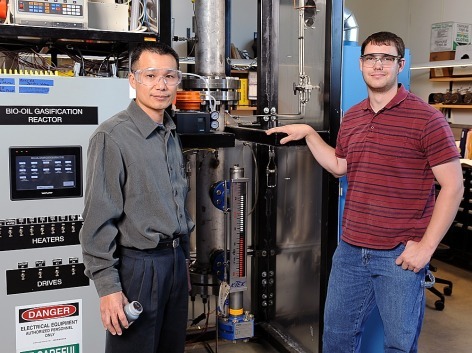
Iowa State engineers Song-Charng Kong, left, and Nicholas Creager are studying a new bio-oil gasifier capable of producing biorenewable fuels. The project is supported by external funding from the U.S. Department of Energy and the Iowa Energy Center. Photo by Bob Elbert.
External funding at Iowa State University dropped to $326.4 million in fiscal year 2013 from the previous fiscal year’s total of $360.2 million, a decrease of $33.8 million or 9.37 percent. Total external funding in the previous fiscal year was the second highest level on record.
Much of the decrease in funding is attributable to the federal sequester, the across-the-board cuts mandated by 2011 legislation and triggered when budget negotiations failed in Congress. The Association of Public and Land Grant Universities estimated that sequestration would mean $10 billion less in government support for research and development in FY2013 alone and $90 billion less through FY2021.
Total federal funding at Iowa State is down a little more than 17 percent over last year’s total, ending at $172.7 million. University leaders say a portion of federal funding was simply delayed by the sequester, particularly funding from the Department of Agriculture, and they expect to see more transfers by the end of the federal fiscal year ending Sept. 30.
Despite ongoing challenges in securing federal funding, Iowa State University President Steven Leath said the university continues its exceptional record in competing for grants, contracts, gifts and other sources of sponsored funding.
Five straight years of $300-million-plus
“Iowa State has attracted over $300 million annually in external support over the past five consecutive years,” said Leath. “That we have continued to attract outside funding at this level despite the difficulties associated with the sequester shows how successful we are at building upon our core strengths and leveraging investments in our research and scholarship.”
The external funding, which comes from federal, state and local government sources as well as from private corporations, foundations and other universities, is in addition to the state appropriation that supports daily university operations.
Total non-federal external funding was up this year by 1.45 percent, at $153.7 million, with contributions from foundations and associations increasing by almost 13 percent over last year’s level.
Of the $326.4 million total, $193.8 million was the result of successful research proposals submitted by Iowa State faculty and scientific staff.
The external funding supports student financial aid, research, education and extension programs.
“Every dollar we receive from external funding supports our mission of providing high-quality education, applying research and extending knowledge to strengthen Iowa’s economy,” said David Oliver, interim vice president for research and economic development. “We rely on these dollars to continue our commitment to preparing outstanding students, supporting our scientists in their pursuit of basic research and invention and growing the economy of our state and nation.”
Leath appoints Michael Crum to economic development post
Michael Crum, holder of the Ruan Chair in Supply Chain Management, will become senior policy adviser on economic development to President Steven Leath on Aug. 1. At the end of this month, Crum completes a 16-month interim dean appointment in the College of Business.
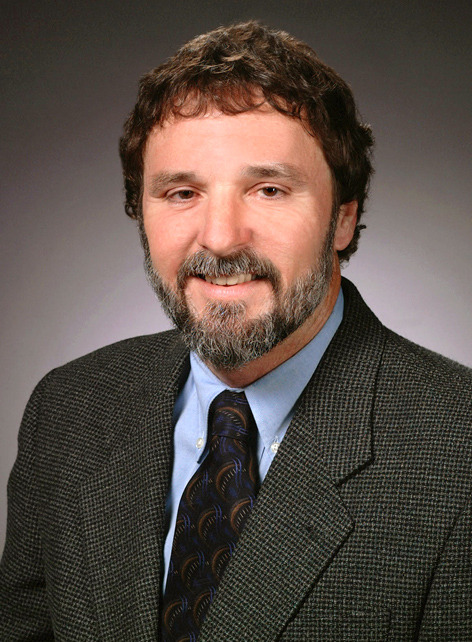
Michael Crum
As senior policy adviser, Crum will make recommendations to Leath on all matters related to economic development, with the intent of expanding the university's contributions to both the state and national economies. He will develop a plan for strengthening Iowa State's economic development enterprise, including its organization and alignment, efficiency, effectiveness, accessibility and responsiveness. He also will represent the university on key external partnerships and task forces.
"I'm extremely happy to appoint Mike to this post," Leath said. "He is uniquely qualified, given his years of experience in the College of Business and on the board of the ISU Research Park. He knows all the relevant stakeholders -- both on- and off-campus -- and those relationships will be essential as the university strives to promote economic development across the state and beyond."
Internal and external roles
In his new role, Crum will work with internal and external groups. In addition to representing Iowa State on economic development boards, he'll work to strengthen coordination with constituents that include those boards, business associations, government agencies, communities and foundations. Crum will serve as a gateway for Iowa's business community to the expertise and business services offered through Iowa State.
Crum will develop a comprehensive system for tracking all of the university's economic development activities, including their performance and outcomes. He also will be involved in developing a marketing plan for the economic development enterprise. He will make recommendations to Leath on economic development considerations such as:
- Strategic goals and priorities
- Allocation of resources
- Integration/coordination of functions and activities
Leath noted that some of Crum's responsibilities formerly rested with the vice president for research and economic development. But many of them are new, reflecting Leath's decision to expand Iowa State's role in the state's economic development efforts. When it's completed in the next few years, Crum will have an office in Iowa State's new economic development building at the research park. In the meantime, he will work out of his Gerdin office. The recipient of several teaching awards, Crum also will continue teaching in the College of Business on a part-time basis.
"It is an honor and a privilege to accept this position," Crum said. "There are many Iowa State units, programs and individuals making significant contributions to our state and national economies. I am very much looking forward to working with them to determine how we can expand and improve our efforts in this important area."
More on Michael Crum
Crum has served as chairman of the ISU Research Park's board of directors since 2004, joining the board two years earlier.
Crum joined Iowa State's business faculty in 1980. He served as a department chair from 1998 to 2001, and held the John and Ruth DeVries Endowed Chair in Business from 2004 to 2011. He has served on many committees, whose purposes were as varied as academic searches and reviews, Faculty Senate proceedings, student athletes' academic progress and strategic planning. He was the college's associate dean for graduate programs from 2005 to 2012 and has served as interim dean of the college since March 2012; that appointment ends July 31 with the arrival of incoming dean David Spalding.
Small brass floor plug is part of big project
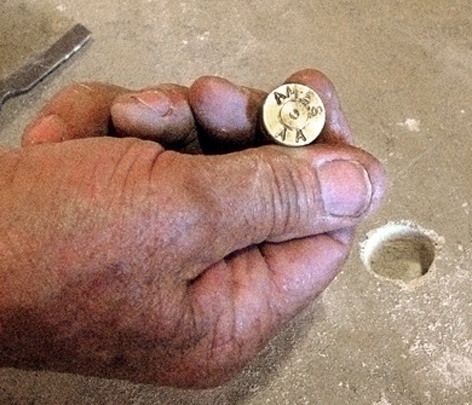
Field technicians working with the National Geodetic Survey stopped by the Christian Petersen Art Museum in Morrill Hall on July 15 with a heavy-duty drill and a brass plug. Their job was to drill a hole in the floor and glue the plug in place. Next summer, researchers will set a nearly $2 million instrument on the plug to measure absolute gravity at that spot. The mark allows researchers to do any follow-up studies at the same spot.
Franek Hasiuk, assistant professor of geological and atmospheric sciences, says gravity varies depending on your distance from the center of the Earth and the material underground. The field work is part of an update of the National Spatial Reference System, the basis for all federal mapping activities. Here, technician Don Breidenbach shows off the Ames gravity mark. Photo by Mike Krapfl.
On the phone
Editor's note: Iowa State University no longer uses Aastra telephone products. Information about current phone hardware is in IT portal's voice and conferencing services.
This week's tips
- Do not disturb (DND)
- Ignore a call
- Pick up a second call
- Special ring for certain callers
Aastra 6737i or Aastra 6739i
Sometimes, you need to avoid ringing interruptions -- temporarily, at least. The new phones offer a variety of ways not to answer your phone. These vary from the "do not disturb" feature that redirects your incoming calls before the first ring, to on-screen buttons that allow you to silence a ring mid-stream and send your caller to voice mail or another number.
Voice mail is the default landing spot for most rerouted calls, but you can set your "predefined forward/busy destination," as it's called in the Aastra instruction manual, to other numbers. And if you want to be extra sure that you don't miss an important call, you can set your phone portal to send you an email whenever you get calls from specified people. You won't know what the call was about, but you'll know who called and when.
Left your receiver off hook? No worries
If you've left your receiver off the hook and you're not connected to another call, your phone will figure it out and fix things within about 45 seconds. When a call comes in while the receiver is off-hook, just answer by tapping the "answer" softkey, the blinking line or the switch hook in the receiver cradle.
Aastra 6739i: When you can't pick up, special rings, juggling two calls
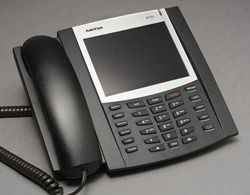
Aastra 6739i (PDF user guide)
Do not disturb (DND)
This feature allows you to block incoming calls before they even ring at your phone. Callers will be sent directly to your predefined call forward/busy destination, usually your voice mail.
- Press the "DND" key to toggle "do not disturb" on and off; DND is in effect when the button light is on
-
If you want your phone to beep an alert whenever DND is sending a caller elsewhere:
- Sign into the portal at phone.iastate.edu
- Click "incoming calls" and then "do not disturb"
- Check "play ring reminder when a call is blocked"
- Leave "do not disturb" in "off" position on the portal. It's more convenient to toggle DND off and on from your phone.
- Press "apply" or "OK"
Ignore a call
There are several ways to ignore an incoming call. While the phone is ringing:
- Press the "reject" softkey, sending the caller to voice mail
- Press the "goodbye" key, sending the caller to voice mail
- Press the "silence" softkey; this silences the ringer and sends the caller to a pre-defined destination, usually your voice mail
Pick up a call while you're on another call
When you're on a call and another caller is trying to reach you, you'll hear two quick beeps. You can simply ignore the incoming call and let it roll to voice mail. However, it's possible to answer the second caller and put the first caller on hold.
- Look for the blinking line key (that's the new caller)
- Let your first caller know you're putting him/her on hold and press the blinking line
- You'll now be connected to the second caller; the first caller will hear music
- Toggle between the two lines to talk to the first or second caller
A special ring for certain callers
The priority alert option allows you to assign a special ring to some callers -- for example, all external callers or certain colleagues or family members. Your phone only has one special ring. It's a subtle variation of whatever ringtone you've selected, but the cadence is two quick rings in the place of a longer, single ring.
- If you haven't done so, set up your portal
- Go to phone.iastate.edu and sign in
- In the left navigation, click "incoming calls"
- Under the "advanced" column, click "priority alert"
- Click the "add" button to set up alerts
- Click "OK"
Aastra 6737i: When you can't pick up, special rings, juggling two calls
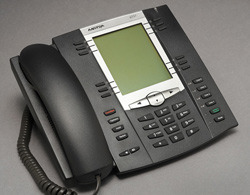
AAstra 6737i (PDF user guide)
Do not disturb (DND)
This feature allows you to block incoming calls before they even ring at your phone. Callers will be sent directly to your predefined call forward/busy destination, usually your voice mail.
- Press the "DND" key to toggle "do not disturb" on and off; DND is in effect when the button light is on
-
If you want your phone to beep an alert whenever DND is sending a caller elsewhere:
- Sign into the portal at phone.iastate.edu
- Click "incoming calls" and then "do not disturb"
- Check "play ring reminder when a call is blocked"
- Leave "do not disturb" in "off" position on the portal. It's more convenient to toggle DND off and on from your phone.
- Press "apply" or "OK"
Ignore a call
- While the phone is ringing, press the "ignore" softkey
- The call immediately will go to your forward/busy destination, usually your voice mail
Pick up a call while you're on another call
When you're on a call and another caller is trying to reach you, you'll hear two quick beeps. You can simply ignore the incoming call and let it roll to voice mail. However, it's possible to answer the second caller and put the first caller on hold.
- Look for the blinking line key (that's the new caller)
- Let your first caller know you're putting him/her on hold and press the blinking line
- You'll now be connected to the second caller; the first caller will hear music
- Toggle between the two lines to talk to the first or second caller
A special ring for certain callers
The priority alert option allows you to assign a special ring to some callers -- for example, all external callers or certain colleagues or family members. Your phone only has one special ring. It's a subtle variation of whatever ringtone you've selected, but the cadence is two quick rings in the place of a longer, single ring.
- If you haven't done so, set up your portal
- Go to phone.iastate.edu and sign in
- In the left navigation, click "incoming calls"
- Under the "advanced" column, click "priority alert"
- Click the "add" button to set up alerts
- Click "OK"
